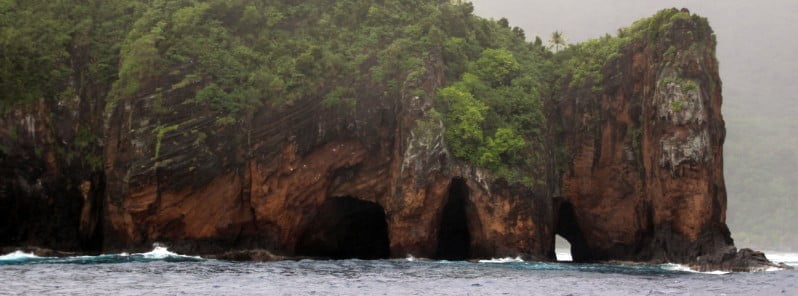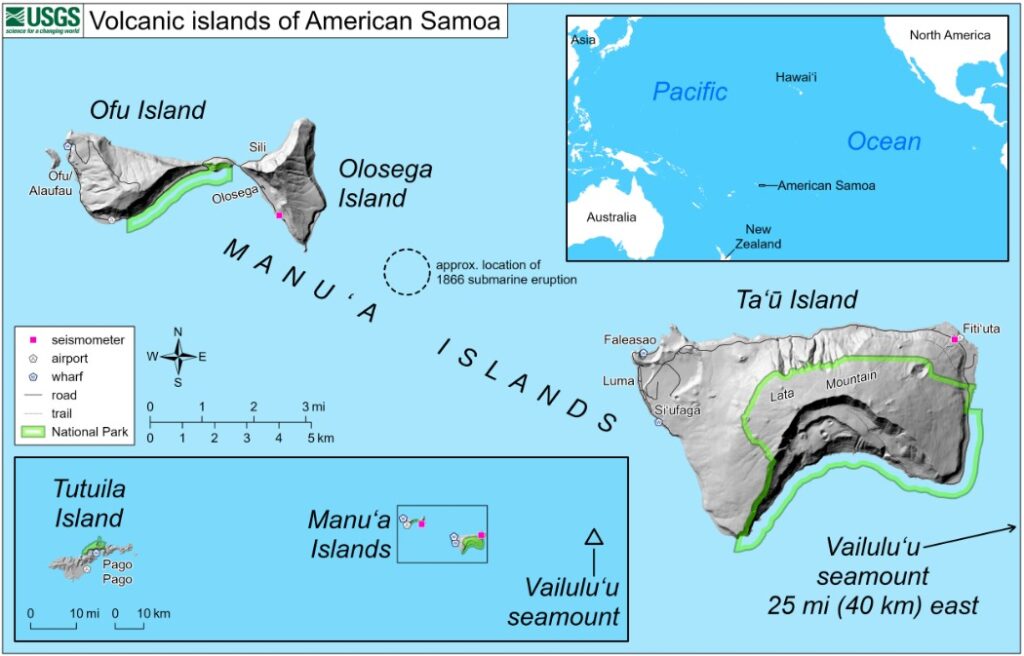Aviation Color Code for Ta’u and Ofu-Olosega volcanos raised to Yellow, American Samoa

The earthquake swarm that started in the Manua’ Islands, American Samoa on July 26, 2022, continues without abating. As a result, the Hawaiian Volcano Observatory (HVO) has raised the Aviation Color Code for Ta’u and Ofu-Olosega volcanoes to Yellow.
Based on felt reports and historic activity, Taʻū and Vailuluʻu seamount were initially identified as possible sources for the recent earthquakes in the region.
However, it was difficult to confirm the source until a few days ago as there were no seismometers close enough to determine the distance to the source of the earthquakes.1
The latest seismic data indicates that the source for these earthquakes is beneath the Manuʻa Islands, likely closer to Taʻū island rather than Ofu-Olosega.
On August 18, HVO said approximately 20 earthquakes per hour are being recorded by the two microseismometers installed in the Manuʻa islands, but most of them are too small to be felt. Estimated magnitudes of the largest earthquakes, including the felt events, are between M2 and 3.
Reports from both Taʻū and Ofu-Olosega islands suggest that the earthquakes vary in intensity, but are generally short, sharp jolts.
Current low-level earthquake activity may continue and vary in intensity for days to months or longer without an eruption, HVO said, adding that it’s also possible that the swarm is an early precursor to an eventual eruption.
“At this time, we cannot determine which of these possibilities is more likely. A large explosive eruption similar to the Tonga eruption earlier this year is extremely unlikely. ”2

Ofu and Olosega, separated by the narrow Asaga Straight, are the tops of two shield volcanoes. Taʻū, the largest of the Manuʻa group, is a shield volcano with rift zones to the northeast and northwest.
The youngest dated eruption in American Samoa on land is on Tutuila, approximately 1 400 – 1 700 years ago. However, numerous submarine eruptions have occurred more recently at volcanoes east of island, such as the one in 1866 – a submarine eruption that formed a cone between Taʻū and Olosega.
Volcanoes in American Samoa are similar to those in Hawaii, with the Pacific Plate moving to the northwest over the Samoa hotspot and building submarine volcanoes that eventually emerge from the ocean as islands. These islands are the tops of large basaltic shield volcanoes rising over 4.5 km (15 000 feet) from the surrounding seafloor.
Geological summary
The 10 km (6.2 miles) wide Ta’u Island, located at the E end of the Samoan islands, is ringed by sea cliffs. It is the emergent portion of the large Lata shield volcano.
A major flank collapse event around 22 ka resulted in the steep scarps on the southern side of the island. Two smaller shields were constructed along rift zones at the NW and NE tips of the island.
The NW corner of the island has a tuff-cone complex that ejected large dunite xenoliths and coral blocks. Numerous Holocene post-caldera cones occur at the summit and on the flanks.3
References:
1 Volcano Watch: HVO Responds to American Samoa Earthquake Reports – HVO – August 18, 2022
2 Earthquake swarm in American Samoa continues, source beneath Manu’a Islands – The Watchers – August 18, 2022
3 Ta’u – Geological summary – GVP
Featured image: View of south part of western side of Nuʻutele Island, off the west coast of Ofu Island in the Manuʻa Islands, American Samoa. Nuʻutele Island is an eroded tuff cone of Ofu-Olosega volcano. A tuff cone can form when magma and water interact at shallow depths, causing localized explosions. The layers exposed within the unvegetated cliff are the result of individual explosions during the eruption that created this tuff cone. The age of the eruption which formed Nuʻutele Island is thought to be Holocene (erupted within the last 12 000 years). After the eruption, ocean waves and currents eroded part of the tuff cone. Credit: USGS/N. Deligne.

Commenting rules and guidelines
We value the thoughts and opinions of our readers and welcome healthy discussions on our website. In order to maintain a respectful and positive community, we ask that all commenters follow these rules.